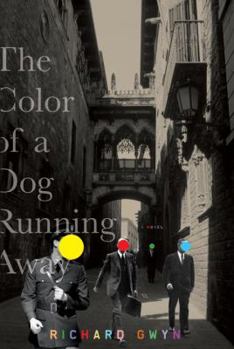The Color of a Dog Running Away
Select Format
Select Condition 
Book Overview
Lucas, a musician and translator living in Barcelona's Gothic Quarter, comes home one day to find a cryptic invitation to a local art gallery slipped under his door. When he appears at the appointed... This description may be from another edition of this product.
Format:Hardcover
Language:English
ISBN:0385518552
ISBN13:9780385518550
Release Date:March 2007
Publisher:Doubleday Books
Length:305 Pages
Weight:1.35 lbs.
Dimensions:1.2" x 6.6" x 9.5"
Customer Reviews
3 ratings
We are certain it could happen
Published by Thriftbooks.com User , 16 years ago
This review is for the Doubleday first U.S. hardcover edition, 2006, 305 pages. THE COLOR OF A DOG RUNNING AWAY does not appear on the USA Today's Top 150 Best-Selling book list. I purchased this book in May 2007 for a good reason, which I immediately forgot. Eighteen months later, I blew off the dust and read the flyleaf. It's about some guy in Barcelona who receives an anonymous postcard that leads to a torrid love affair with Nuria and their abduction by a religious cult, from which he escapes but she stays, and he returns to Barcelona where, in a drug and alcohol induce daze, he tries to figure out what happened. The flyleaf also mentions roof dwellers and a fire-eating prophet. Except for the last 23 pages of the novel, that synopsis tells the story. Nevertheless, the tale has elements of a mystery. THE COLOR...is the first novel by a poet. I classify it as general fiction with perhaps a literary treatment, I say perhaps because I'm too lazy to understand poetry and I suspect there is meaningful theme in this story that other readers will grasp. That theme is likely related to a statement by the character Igbar Zoff on page 70: "The point is that out of any situation, whether disastrous or not, can spring unforeseeable benefits." I think the author was foretelling. This being a first novel I proceeded with caution. For quite many pages, the author seemed to be painting the seedy characters and backstreets of Barcelona where tourists should not go or they will be mugged. Indeed, a tourist mugging is the first scene after the prologue. There are other scenes unrelated to the plot or subplots. Descriptions are sensual, adjectives used liberally, poetically perhaps. But it is interesting. The author lets us see, feel and smell Barcelona's dirty underwear. At times, the author approaches magical realism but then decisively withdraws. It might be surreal, but he makes it plausible. And it works. The flyleaf told us the plot, so with patience and fortitude we wait while the author carefully constructs a foundation on the rubble of Barcelona, which teaches us to accept quirky happenings. So by the time the bald-headed megalomaniac drips water on the trussed up protagonist-narrator lying in a coffin, we are certain it could happen.
Truth, what is truth in this story?
Published by Thriftbooks.com User , 16 years ago
One afternoon Lucas arrives at his apartment in Barcelona's Gothic Quarter to find a mysterious invitation slipped under his door. Written in green ink on a Joan Miró postcard, the note simply states "20-May-11:00." Guessing that the message is intended to draw him to the Miró Foundation, Lucas arrives at the appointed time and meets Nuria, with whom he begins a passionate love affair. Consumed by the new relationship, Lucas discounts his feeling of being watched, until the night he meets "the roof people," who have been instructed to make contact with him. A short while later, Lucas and Nuria are kidnapped by a religious cult who believe they are reincarnated Cathars from the thirteenth century. While Lucas resists the efforts of the group's leader Pontneuf, Nuria appears open to the idea. Suddenly Lucas begins to doubt Nuria's affection and wonder if she is complicit in the scheme. As the narrator states in the prologue, "the color of a dog running away" is "an idiom referring to something of an indeterminate or vague and shadowy appearance, perhaps suggesting a fugitive reality." In The Color of a Dog Running Away, Richard Gwyn's first novel, the narrator relates a surreal tale that is at times chaotic, confusing and beguiling. Lucas views his relationship with Nuria as a new beginning, "a path free of the dead-ends and fruitless affairs to date," yet the hints in the prologue suggest that readers should view everything in The Color of a Dog Running Away as transitory, including this powerful new relationship. In a novel full of symbolic dead ends, dangers, catastrophes and stagnation, the reader is left to wonder whether the tale is one that haunts the narrator or if this is an allegorical novel constructed to lead to spiritual awakening and rebirth for both Lucas and the reader. Either way, this is a story that will remain with you long after the final world is read, leaving you "touched by a sense of grief and loss for a life not lived, a path not chosen." Armchair Interviews says: This book keeps your interest
Recommended -- Refreshingly different and literate
Published by Thriftbooks.com User , 17 years ago
I finished Richard Gywn's The Color of a Dog Running Away last night. Whilst I enjoyed the book overall, the last half doesn't sustain the excellence of the first half. A very good read, nonetheless; refreshingly different and literate. The Barcelona setting is a delight throughout. The Cathar theme is inspired. Recommended.






